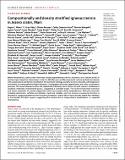Compositionally and density stratified igneous terrain in Jezero crater, Mars
Author(s)
Bosak, Tanja; Weiss, Benjamin
DownloadPublished version (1.940Mb)
Publisher with Creative Commons License
Publisher with Creative Commons License
Creative Commons Attribution
Terms of use
Metadata
Show full item recordAbstract
<jats:p>Before Perseverance, Jezero crater’s floor was variably hypothesized to have a lacustrine, lava, volcanic airfall, or aeolian origin. SuperCam observations in the first 286 Mars days on Mars revealed a volcanic and intrusive terrain with compositional and density stratification. The dominant lithology along the traverse is basaltic, with plagioclase enrichment in stratigraphically higher locations. Stratigraphically lower, layered rocks are richer in normative pyroxene. The lowest observed unit has the highest inferred density and is olivine-rich with coarse (1.5 millimeters) euhedral, relatively unweathered grains, suggesting a cumulate origin. This is the first martian cumulate and shows similarities to martian meteorites, which also express olivine disequilibrium. Alteration materials including carbonates, sulfates, perchlorates, hydrated silicates, and iron oxides are pervasive but low in abundance, suggesting relatively brief lacustrine conditions. Orbital observations link the Jezero floor lithology to the broader Nili-Syrtis region, suggesting that density-driven compositional stratification is a regional characteristic.</jats:p>
Date issued
2022Department
Massachusetts Institute of Technology. Department of Earth, Atmospheric, and Planetary SciencesJournal
Science Advances
Publisher
American Association for the Advancement of Science (AAAS)
Citation
Bosak, Tanja and Weiss, Benjamin. 2022. "Compositionally and density stratified igneous terrain in Jezero crater, Mars." Science Advances, 8 (34).
Version: Final published version